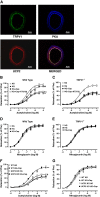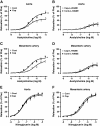TRPV1-mediated UCP2 upregulation ameliorates hyperglycemia-induced endothelial dysfunction
- PMID: 23607427
- PMCID: PMC3644255
- DOI: 10.1186/1475-2840-12-69
TRPV1-mediated UCP2 upregulation ameliorates hyperglycemia-induced endothelial dysfunction
Abstract
Background: Diabetic cardiovascular complications are characterised by oxidative stress-induced endothelial dysfunction. Uncoupling protein 2 (UCP2) is a regulator of mitochondrial reactive oxygen species (ROS) generation and can antagonise oxidative stress, but approaches that enhance the activity of UCP2 to inhibit ROS are scarce. Our previous studies show that activation of transient receptor potential vanilloid 1 (TRPV1) by capsaicin can prevent cardiometabolic disorders. In this study, we conducted experiments in vitro and in vivo to investigate the effect of capsaicin treatment on endothelial UCP2 and oxidative stress. We hypothesised that TRPV1 activation by capsaicin attenuates hyperglycemia-induced endothelial dysfunction through a UCP2-mediated antioxidant effect.
Methods: TRPV1(-/-), UCP2(-/-) and db/db mice, as well as matched wild type (WT) control mice, were included in this study. Some mice were subjected to dietary capsaicin for 14 weeks. Arteries isolated from mice and endothelial cells were cultured. Endothelial function was examined, and immunohistological and molecular analyses were performed.
Results: Under high-glucose conditions, TRPV1 expression and protein kinase A (PKA) phosphorylation were found to be decreased in the cultured endothelial cells, and the effects of high-glucose on these molecules were reversed by the administration of capsaicin. Furthermore, high-glucose exposure increased ROS production and reduced nitric oxide (NO) levels both in endothelial cells and in arteries that were evaluated respectively by dihydroethidium (DHE) and DAF-2 DA fluorescence. Capsaicin administration decreased the production of ROS, restored high-glucose-induced endothelial dysfunction through the activation of TRPV1 and acted in a UCP2-dependent manner in vivo. Administration of dietary capsaicin for 14 weeks increased the levels of PKA phosphorylation and UCP2 expression, ameliorated the vascular oxidative stress and increased NO levels observed in diabetic mice. Prolonged dietary administration of capsaicin promoted endothelium-dependent relaxation in diabetic mice. However, the beneficial effect of capsaicin on vasorelaxation was absent in the aortas of UCP2(-/-) mice exposed to high-glucose levels.
Conclusion: TRPV1 activation by capsaicin might protect against hyperglycemia-induced endothelial dysfunction through a mechanism involving the PKA/UCP2 pathway.
Figures







Similar articles
-
Ameliorating Endothelial Mitochondrial Dysfunction Restores Coronary Function via Transient Receptor Potential Vanilloid 1-Mediated Protein Kinase A/Uncoupling Protein 2 Pathway.Hypertension. 2016 Feb;67(2):451-60. doi: 10.1161/HYPERTENSIONAHA.115.06223. Epub 2015 Dec 14. Hypertension. 2016. PMID: 26667415
-
Dietary curcumin ameliorates aging-related cerebrovascular dysfunction through the AMPK/uncoupling protein 2 pathway.Cell Physiol Biochem. 2013;32(5):1167-77. doi: 10.1159/000354516. Epub 2013 Nov 11. Cell Physiol Biochem. 2013. PMID: 24335167
-
Uncoupling protein-2 protects endothelial function in diet-induced obese mice.Circ Res. 2012 Apr 27;110(9):1211-6. doi: 10.1161/CIRCRESAHA.111.262170. Epub 2012 Mar 29. Circ Res. 2012. PMID: 22461387
-
Capsaicin and TRPV1 Channels in the Cardiovascular System: The Role of Inflammation.Cells. 2021 Dec 22;11(1):18. doi: 10.3390/cells11010018. Cells. 2021. PMID: 35011580 Free PMC article. Review.
-
Mitochondrial UCP2 in the central regulation of metabolism.Best Pract Res Clin Endocrinol Metab. 2014 Oct;28(5):757-64. doi: 10.1016/j.beem.2014.02.006. Epub 2014 Mar 7. Best Pract Res Clin Endocrinol Metab. 2014. PMID: 25256770 Review.
Cited by
-
Endothelial dysfunction in neuroprogressive disorders-causes and suggested treatments.BMC Med. 2020 Oct 19;18(1):305. doi: 10.1186/s12916-020-01749-w. BMC Med. 2020. PMID: 33070778 Free PMC article. Review.
-
Hesperidin and capsaicin, but not the combination, prevent hepatic steatosis and other metabolic syndrome-related alterations in western diet-fed rats.Sci Rep. 2018 Oct 10;8(1):15100. doi: 10.1038/s41598-018-32875-4. Sci Rep. 2018. PMID: 30305645 Free PMC article.
-
Mitochondria, endothelial cell function, and vascular diseases.Front Physiol. 2014 May 6;5:175. doi: 10.3389/fphys.2014.00175. eCollection 2014. Front Physiol. 2014. PMID: 24834056 Free PMC article. Review.
-
Uncoupling Protein 2: A Key Player and a Potential Therapeutic Target in Vascular Diseases.Oxid Med Cell Longev. 2017;2017:7348372. doi: 10.1155/2017/7348372. Epub 2017 Oct 15. Oxid Med Cell Longev. 2017. PMID: 29163755 Free PMC article. Review.
-
Dietary Capsaicin Protects Cardiometabolic Organs from Dysfunction.Nutrients. 2016 Apr 25;8(5):174. doi: 10.3390/nu8050174. Nutrients. 2016. PMID: 27120617 Free PMC article. Review.
References
-
- Zou MH, Shi C, Cohen RA. High glucose via peroxynitrite causes tyrosine nitration and inactivation of prostacyclin synthase that is associated with thromboxane/prostaglandin H(2) receptor-mediated apoptosis and adhesion molecule expression in cultured human aortic endothelial cells. Diabetes. 2002;51(1):198–203. - PubMed
Publication types
MeSH terms
Substances
LinkOut - more resources
Full Text Sources
Other Literature Sources
Molecular Biology Databases
Miscellaneous

